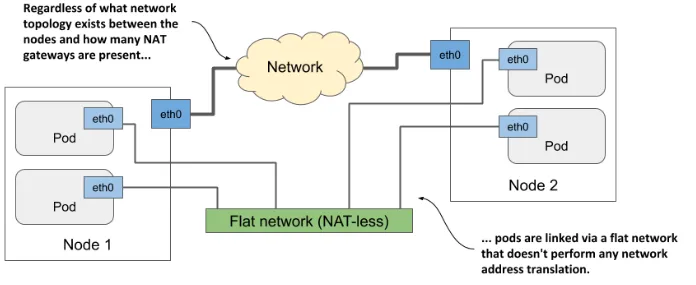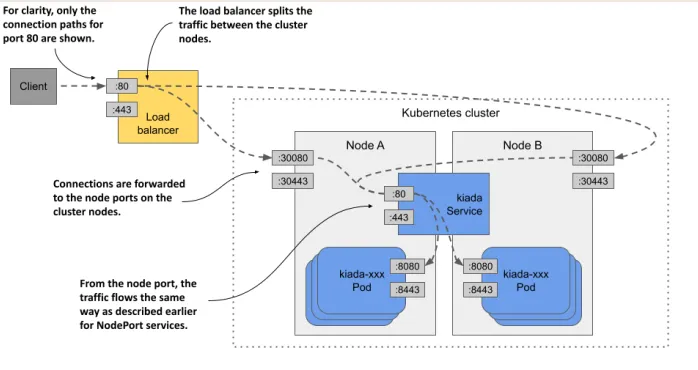Services
Pods can communicate with each other using private IP address space. They can be on different nodes, but K8s handles appropriate routing. For a pod, all other pods are on the same LAN.

Problems:
- Pods are ephemeral and their IP might suddenly change.
- Pods are not accessible on the outside by default.
Services enable a single communication entry point to the pods. There’ll be a single IP address regardless of how many replicas are deployed.
Service’s IP never changes, it’s static, unlike the IPs of pods (pods die, and new ones get created).
Services operate at the Layer 4 of the OSI model. They do not understand URLs, cookies (e.g. cookie-based affinity is not supported, only IP-based is supported), etc.
Creating a simple service: kubectl expose deployment kiada --type=LoadBalancer --port 8080. It exposes all pods in the “kiada” deployment as a new service.
The pods will be accessible via a load balancer. Service name is inherited from
the deployment since we didn’t specify any name.
DNS
K8s runs pods with DNS servers (and a service to expose them as ClusterIP!), which all pods are configured to use. Thanks to them, service’s IP is resolvable by service’s name. If a service resides in a different namespace than the client pod, the namespace must be appended to the URL. Examples:
http://quiz- when thequizservice is in the same nshttp://quiz.kiada- when thequizservice is in another namespace (calledkiada)
The IP addresses of services in a namespace are also available as envs in all
pods (the pod needs to be started after the service is created!). It’s better to
rely on DNS though. These envs may be disabled with enableServiceLinks on a
pod.
Binding services to pods
Services use label selectors to find pods that belong to a Service.

Services types
K8s supports the following Service types:
- ClusterIP - only within the cluster (it’s the default). It acts as a load balancer when multiple pods are behind it.
- NodePort - a port on all nodes takes us to the pod. It is accessible from the outside via any node’s IP. Node ports may be explicitly specified in the manifest or K8s may assign them randomly.
- LoadBalancer - depends on cloud provider. There is an external load balancer in front of the nodes that routes the traffic to the nodes. It is an extension of NodePort. The pods will be accessible via a new IP address belonging to the load balancer.

- ExternalName - creates CNAME records in K8s DNS. They have no clusterIP. The client gets the IP of the CNAMEd service.
Load Balancer
Kubernetes allows to create a service of LoadBalancer type, but it does not provide load balancing itself. It asks the cloud infrastucture (via cloud proivder-specific controller?) to provide it. The IP address of the load balancer becomes an External IP of the service.

Using Minikube or kind, the external IP will always be <Pending>, because load
balancing functionality does not exist (it can be installed though, for example
with MetalLB). We can access the service via any worker node IP with a port of
the service:

These node ports are what the load balancer forwards the traffic to:

There are actually two load balancers:
- cloud-provider one that load balances traffic between nodes
- K8s one that load balances traffic between pods
With such a setup, every request has added latency, there’re a lot of hops (load balancer -> node -> potentially another node if first one didn’t have a pod -> pod). Additionally, original client’s IP is lost due to these hops.
Endpoints
Together with a Service, an Endpoints object is created. Its name matches
that of the Service. It contains a list of {IP}:{PORT} that a given service
leads to together with other metadata (which node, which pod). It is built based
on selectors specified for a service.
There are also EndpointSlices objects, which are created by K8s when the number of endpoints of a service is large. Sending around a huge Endpoints object in a cluster becomes a performance issue. One Endpoints object may be splitted into multiple EndpointSlices. These two types of objects exist at the same time (why?).
These objects are fully managed by K8s, it automatically updates Endpoints/EndpointSlices as pods are created/deleted - only if a service has a label selector! If it doesn’t, we need to create Endpoints objects by ourselves. We don’t need to create EndpointSlices, K8s will do that for us based on Endpoints object. It’s useful when we want to expose some external service via a Service to the pods with an internal DNS name. We could, for example, switch from some K8s-hosted service to an external one (e.g. a DB) and just by removing a selector from a Service and creating Endpoints object that would work. The pods wouldn’t notice any difference. We could also do the opposite.
Availability of a given pod in Endpoints object depends from the status of the
readiness probe of that pod. If it’s not ready,
it’ll be moved to notReadyAddresses in the Endpoints object. Readiness of pods
may also be ignored by Services with proper configuration. Additionally, K8s
automatically removes pods that are being shut down from Endpoints.
Headless Services
We can skip the Service hop (pod -> Service -> pod) by creating headless service. When a DNS name of such a service gets resolved, instead of returning service’s IP, the IPs of endpoints behind it are returned.
It enables scenarios such as:
- load balancing from the client side
- ability to contact all pods of a given service
If a pod does not need to know IP addresses of all the pods and it just wants to use the service as normal, it can. The DNS will randomly return any pod’s IP and the client will talk directly to a pod. DNS-aware clients can make use of the advantages listed above though.

Headless services are created by placing clusterIP: None in the YAML definition.
Tips
- Services cannot be pinged